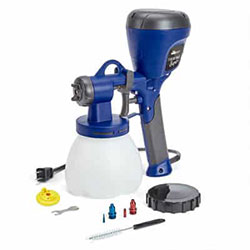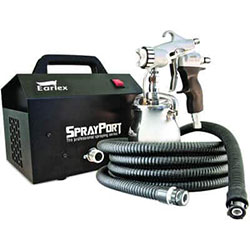The Best HVLP Spray Gun for Woodworking: Buyer’s Guide, Reviews, Comparisons, and How To Spray Wood
With the best HVLP spray gun for woodworking, you can say goodbye to the lost bristles, bubbles, and brushmarks associated with traditional manual staining and varnishing. These versatile sprayers are ideally suited to delivering sealers, polyurethanes, shellacs, and lacquers. Plus, some powerful units are capable of knocking out dense primers and oil-based gloss paints. Fine atomization promises a showroom-like finish, while their HVLP format eliminates overspray, bounceback, and wastage. The range extends from compact and portable handheld units through to hefty external turbine models, so there are sprayers available for both DIYers and pros.
- 1 and 1.5-quart containers.
- Complete with a viscosity cup.
- Three spray patterns and variable material flow control.
- Lock-N-Go technology.
Best HVLP Spray Gun for Woodworking Information
HVLP for woodworking Comparison Table
| IMAGE | PRODUCT | DETAILS | ||
|---|---|---|---|---|
|
Best for Trim and Moldings 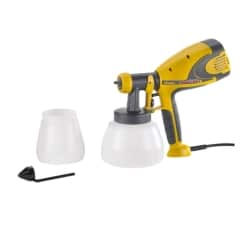
|
Best for Trim and Moldings
|
Features
|
Check Price at Amazon Wagner Control Spray Double Duty Review Wagner Control Spray Double Duty Review | |
|
Best for Large Projects 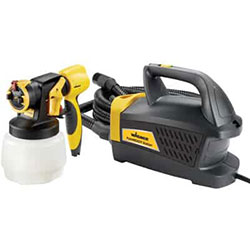
|
Best for Large Projects
|
Features
|
Check Price at Amazon Wagner PaintREADY Station Review Wagner PaintREADY Station Review | |
|
Best Budget 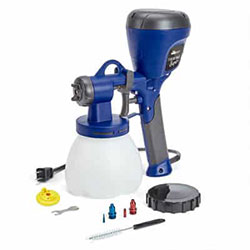
|
Best Budget
|
Features
|
Check Price at Amazon HomeRight Super Finish Max C800971 Review HomeRight Super Finish Max C800971 Review | |
|
Best for Stains and Sealers 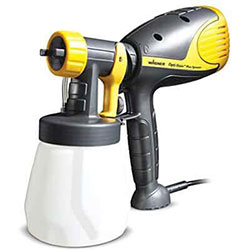
|
Best for Stains and Sealers
|
Features
|
Check Price at Amazon Wagner Opti Stain Plus Review Wagner Opti Stain Plus Review | |
|
Best for Multi-Angle Painting 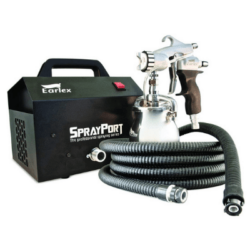
|
Best for Multi-Angle Painting
|
Features
|
Check Price at Amazon Earlex Spray Port 6003 Review Earlex Spray Port 6003 Review |
The Best HVLP Spray Gun for Woodworking: Buying Guide
These affordable tools take your timber coverage to pro-levels, protecting the wood beneath and providing an eye-catching and pleasing appearance. Faster than a brush and ensuring no brush marks or embedded bristles ruining your finish, these versatile units are as suited to hobbyist crafters as they are trade woodworkers.
Why You Need the Best HVLP Spray Gun for Woodworking
However, wood is a notoriously difficult material to address.
Grain direction, natural imperfections, and its propensity to soak up your coating material like a sponge provide challenges for the DIY or trade woodworker — an issue exacerbated by the traditional handheld brush.
The timber coverage staples of varnish, stains, and shellacs are seriously unforgiving — pretty much like my wife. The slightest mistakes are exaggerated and will torment you for years to come — again, like my other half.
These mediums are inherently sticky, acting as a magnet to any loose bristles. Furthermore, every brushstroke you make becomes a historical record of your work, displaying every pass and removing any chance of a smooth, sheer finish.
But, if you obtain one of the best spray guns for woodworking, your projects will have a showroom-like coat.
The advantages of using a spray gun for woodworking include:
- Can cover an area ten times faster than a brush.
- Provides ultra-atomized spray for the cleanest of finishes.
- There are no bristles to become embedded in your lacquer or shellac.
- Eliminates the risk of tell-tale brush marks.
- Can propel paints, stains, lacquers, shellacs, and varnishes.
- Requires little effort.
- No chance of overloading your brush.
- It’s more fun wielding a gun than a brush.
HVLP Woodworking Spray Gun vs Airless
Undoubtedly, the ideal machine for wood projects is an HVLP (high-volume low-pressure) sprayer.
As the name suggests, these units utilize a high volume of air delivered at a relatively low pressure (5 to 10 psi) to propel the coating medium. This results in little overspray, minimal bounceback, and reduces the risk of pooling. Furthermore, with super-fine atomization, they provide the smooth, blemish-free coat that’s crucial for varnishes and shellacs.
This is in contrast to airless machines that knock out over 3000 psi. While ensuring remarkably swift coverage, their finishes are not as smooth as those provided by HVLP units. Additionally, as woodworking mediums are typically low viscosity, the high pressure of airless sprayers can mean over-drenching your base material and significant overspray — leading to unnecessary paint wastage and a disappointing coat.
That’s not to say that airless units don’t have a place in some wood jobs. For large-scale timber projects such as weatherproofing decking or staining fencing, these speedy and powerful painters are ideal as a glossy and immaculate finish isn’t always necessary.
How To Choose the Best Spray Gun for Woodworking
While not exhaustive, here are some factors I suggest examining when selecting your perfect machine.
HVLP Format
As already mentioned, unless your work involves addressing vast expanses of wood — you need an HVLP machine for the ultimate in coat perfection.
Usually, these sprayers come in two formats: turbines and pneumatics.
Turbines are by far the most popular with both DIYers and serious woodworkers. The affordable price point, ease of portability, and straight-outta-the-box operation making them highly practical machines.
Pneumatics are usually the arena of serious trade users. Requiring an external compressor, they’re not ideal for indoor use or where they need to be moved from room to room. That said, their finish exceeds that of turbine models, and as such are often utilized by professional cabinetry restorers.

Handheld or External Turbine
For most woodworking projects, a handheld sprayer such as the Control Spray Double Duty is ideal.
These feature a turbine housed within the gun’s casing, making them compact and highly portable. Typically single-stage machines (driven by one fan), they’re powerful enough to knock out low-viscosity woodworking mediums such as stains, sealers, and shellacs.
External turbines, like the PaintREADY station, have their drive unit in a separate motor housing, which usually sits on the floor. As there are no weight constraints, they can have more stages than handheld models, which means more power. Hence, they can provide faster coverage and propel denser liquids — useful if you’re using an oil-based gloss or thick primers on your wood jobs
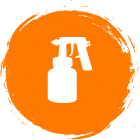
Nozzle Tip
Typically, the smaller the diameter the greater the precision and the smoother the coat. Conversely, larger tips allow you to deliver denser paints and more rapid coverage.
While there are some exceptions (depending on the wattage and psi of the sprayers), a 0.8 to 1.3-mm tip is generally suitable for thin mediums like stains, and 1.3 to 1.8 mm for denser paints such as latexes.

Cord and Hose Length
However, while a Kraken-like hose may be beneficial when tackling substantial jobs such as staining a dining table, it can become a hindrance on more modest projects. There’s no advantage to a 100-foot hose if you’re completing precise work on wood carvings or moldings — it’s just going to get in the way, become a trip hazard, and wrap around you like an angry anaconda.

Paint Cup Volume
Bear in mind that the larger the paint cup, the more weight in your hands. This is a crucial consideration if you’re using a handheld HVLP machine where you already have to wield the weight of the turbine in addition to the container.
How to Use a Paint Sprayer on Woodwork
However, patience, young padawan. Before you crack on, check that you have the following items readily available to ensure the perfect results:
What You Will Need to Follow This Tutorial
- A paint sprayer suitable for woodworking such as the Wagner Control Spray.
- Masking tape. and drop cloths.
- Paint stirrer sticks.
- Woodwork medium — lacquer, shellac, varnish, stain, gloss, or primer.
- Mixing cups.
- Bucket for test spraying.
- Paint scraper.
- Sandpaper. and/or palm sander.
- Paint thinner.
- Wood filler.
- Heat gun.
- Paint stripper.
- Suitable nozzle for the coverage medium.
- Sponge and soapy water.
- Screwdrivers.
- Claw hammer.
- Polythene sheets.
- Overalls.
- Dust mask, safety goggles, and painting gloves.
- Extension cable if operating a distance away from power outlets.
How to Spray Paint Doors and Trim — Step By Step Guide
Step 1 — Preparation
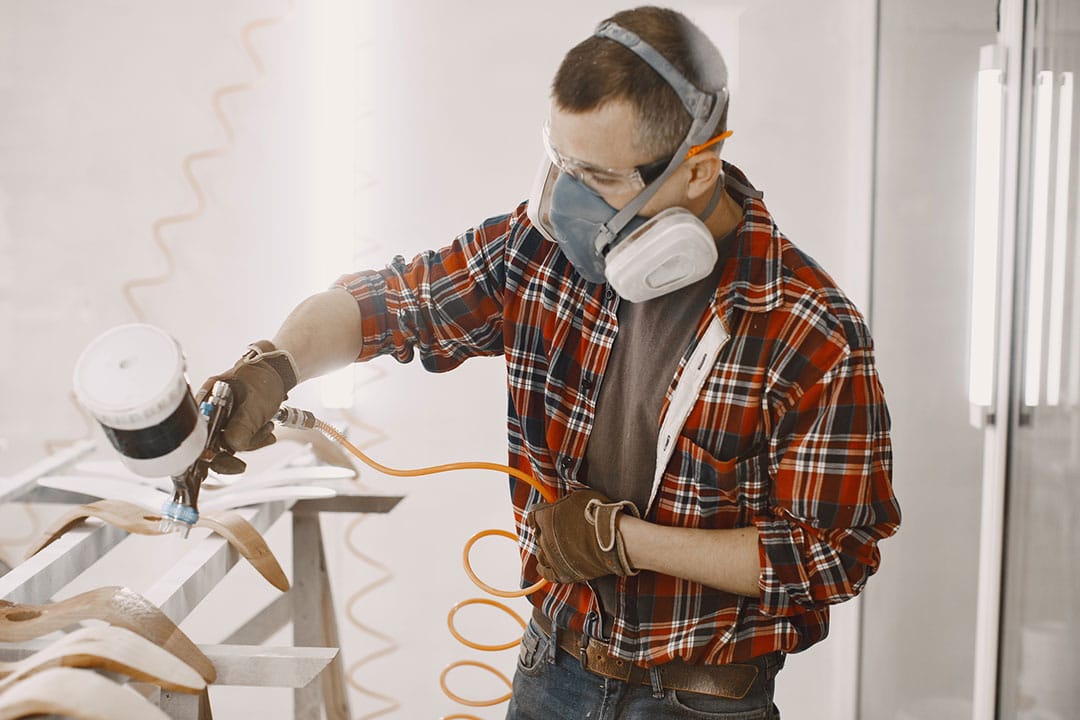
- Put on your protective gear.
- Cover any furniture, ornaments, flooring, or carpeting with drop cloths or plastic sheeting. If you’re working outdoors, protect any planters, cycles, or grills — in fact, cover everything that doesn’t need to be painted or stained.
- Examine the wood for old tacks, screws, and staples sticking above the surface — remove with a claw hammer or screwdriver.
- If the woodwork has additional accessories such as knobs, handles, hinges, knockers, etc. remove these and safely store them.
- If there are areas of your woodwork that don’t need to be painted, shield these with masking tape.
- Make the surface of your woodwork ready for painting. At the very least, sand to a smooth sheen with either glasspaper or a palm sander.
- If required, remove any old paint with a scraper and heat gun. If there are seriously stubborn areas (and the paint is oil-based), consider using a little chemical stripper. For more info, check out my guide to stripping paint from wood.
- Carefully examine the woodwork for nicks, gashes, slits, cuts, holes, and cracks. Fill with wood filler and then sand to a smooth finish.
- Wash the woodwork with a sponge and warm soapy water to remove dust and paint flecks. Allow it to dry thoroughly.
- If you wish, you can give the woodwork a thin coat of primer; this base coat can make any missed imperfections stand out. Gently sand any issues you see and wash again before applying the topcoat.
Step 2: Paint Spraying Woodwork
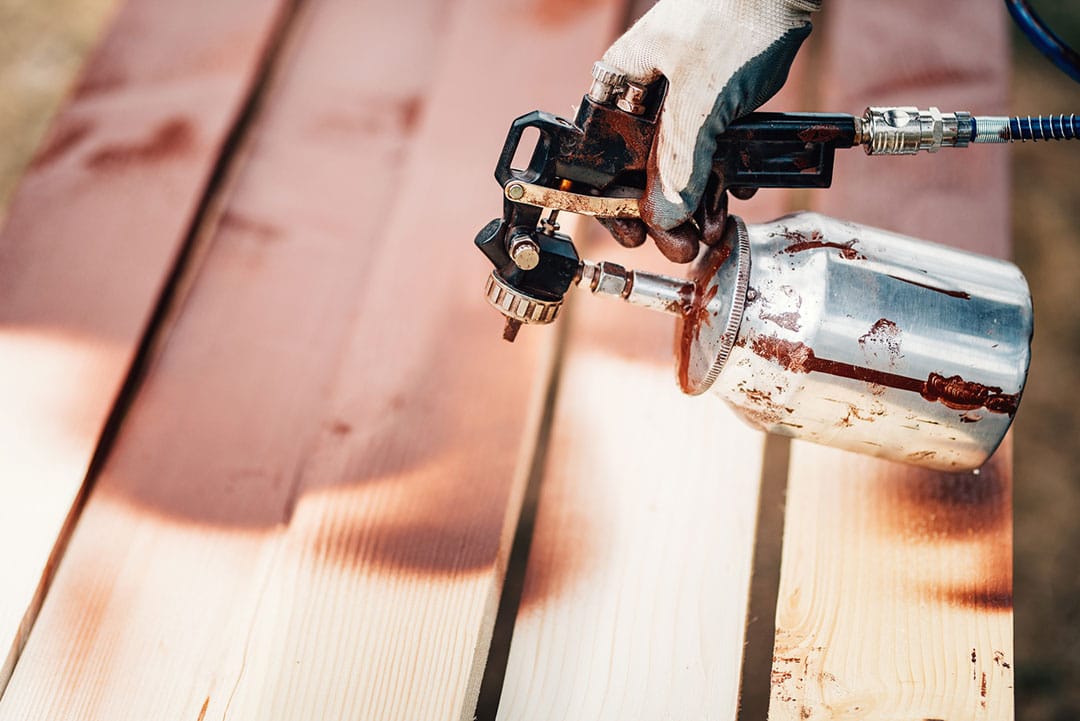
- If necessary, dilute the varnish, stain, or paint — using thinners for oil-based mediums. Ideally, use a non-shedding paint stick and acrylic mixing cups.
- Set up your paint sprayer, following the guidelines from the manufacturer and using an extension cord if needed. Although these machines require different preparation depending on the model, I’ve put together general guides on setting up both turbine and pneumatic units.
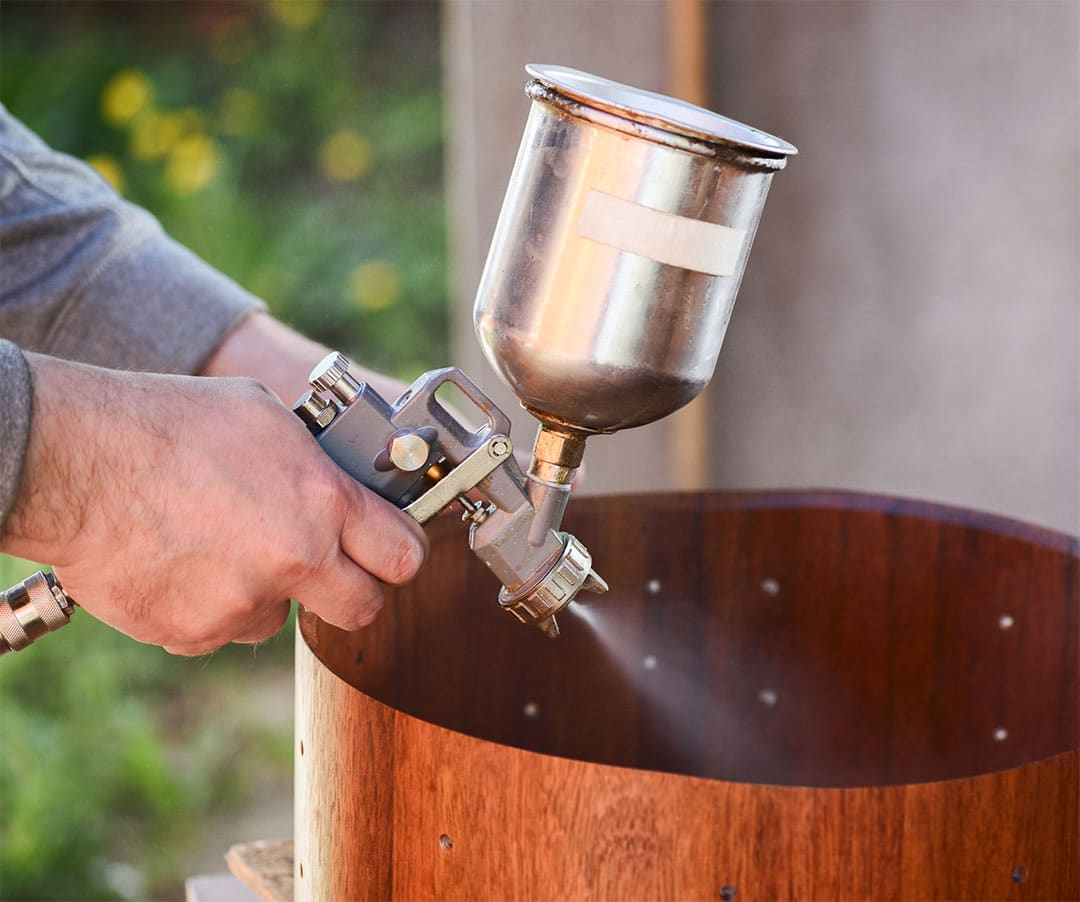
- Execute a test spray into an old bucket to ensure that the paint is flowing smoothly and at the correct delivery intensity for your medium type. Ideally, utilize the lowest power setting possible — this will dramatically cut back on overspray with thin stains and sealers.
- With your gun nozzle 8 to 12 inches from your target material, begin to spray. Where possible, try to follow the wood’s grain. Use long, continuous side-to-side or up and down movements depending on the nature of your projects. Overlap each pass by about 30 to 50 percent.
- Wait for the paint or stain to dry completely, then check the adequacy of coverage. If needed, deliver a second coat.
- Remove the protective masking tape and replace any hardware.
Our Picks of the Best HVLP for Woodworking
Focusing on the keen timber artisan, this handheld HVLP turbine unit boasts a variable flow dial, allowing you to select the delivery intensity to suit both your wood target and coating medium. A modest flow rate of 4.9 ounces per minute ensures steady delivery and prevents over-drenching of your base material. An included viscosity cup allows for effortless thinning if required.
This unit arrives with two paint containers — a one-quart cup for small work that requires precision, and a larger 1.5-quart cup for more substantial timber projects. A six-foot cord permits suitable operational freedom for most woodworking jobs, and a replaceable air filter prevents dirt ingress while ensuring a blemish-free coat.
And, at the end of your working day, this machine features Lock-N-Go technology — you can rapidly dismantle the unit for cleaning.
- Choice of two paint containers.
- Rated for both indoor and outdoor use.
- Designed for moldings, trim, and small woodworking projects.
- Excellent online HVLP spray gun reviews for woodworking.
- Three spray patterns.
- Thicker mediums, such as oil-based paints, will require thinning.
- Design
- Functionality
- Price
Focusing on the keen timber artisan, this handheld HVLP turbine unit boasts a variable flow dial, allowing you to select the delivery intensity to suit both your wood target and coating medium. A modest flow rate of 4.9 ounces per minute ensures steady delivery and prevents over-drenching of your base material. An included viscosity cup allows for effortless thinning if required.
This sprayer includes Wagner’s patented Control Finish nozzle, delivering a smooth and consistent finish with lacquers, shellacs, and varnishes. Additionally, a simple turn of the air cap permits you to switch between three fan patterns: vertical, horizontal, and circular.
This unit arrives with two paint containers — a one-quart cup for small work that requires precision, and a larger 1.5-quart cup for more substantial timber projects. A six-foot cord permits suitable operational freedom for most woodworking jobs, and a replaceable air filter prevents dirt ingress while ensuring a blemish-free coat.
And, at the end of your working day, this machine features Lock-N-Go technology — you can rapidly dismantle the unit for cleaning.
- Choice of two paint containers.
- Rated for both indoor and outdoor use.
- Designed for moldings, trim, and small woodworking projects.
- Excellent online HVLP spray gun reviews for woodworking.
- Three spray patterns.
- Thicker mediums, such as oil-based paints, will require thinning.
- Design
- Functionality
- Price
This HVLP machine boasts a ground-sitting external turbine — reducing the weight of the spray gun and allowing your hands and arms to remain fatigue-free on those larger projects. Furthermore, this unit features two power settings; lower the output for thin sealers and steps and crank it up for thick wood primers and oil-based paints.
In keeping with its large-scale suitability, the unit incorporates a 15-foot hose — meaning less frequent relocation of the base unit on significant jobs. And, its 1.5-quart paint container has sufficient volume to paint over 120 square feet of timber without refilling.
- Features a carrying handle to increase portability.
- Easy-to-clean turbine housing.
- Proprietary iSpray tech promises an even wood coat.
- Compatible with unthinned timber paints.
- Delivers 15 ounces of coverage per minute.
- Lacks a fine-finish head to address trim, decorative work, and moldings.
- Design
- Functionality
- Price
This HVLP machine boasts a ground-sitting external turbine — reducing the weight of the spray gun and allowing your hands and arms to remain fatigue-free on those larger projects. Furthermore, this unit features two power settings; lower the output for thin sealers and steps and crank it up for thick wood primers and oil-based paints.
At the business end of the sprayer is Wagner’s respected iSpray head — a nozzle that’s as happy knocking out low-viscosity varnishes and shellacs as it is dense latexes and chalks. Additionally, it possesses a choice of three spray patterns, together with adjustable spray fan width, and the ability to adjust the volume delivery, preventing overspray, drenching, and wastage.
In keeping with its large-scale suitability, the unit incorporates a 15-foot hose — meaning less frequent relocation of the base unit on significant jobs. And, its 1.5-quart paint container has sufficient volume to paint over 120 square feet of timber without refilling.
- Features a carrying handle to increase portability.
- Easy-to-clean turbine housing.
- Proprietary iSpray tech promises an even wood coat.
- Compatible with unthinned timber paints.
- Delivers 15 ounces of coverage per minute.
- Lacks a fine-finish head to address trim, decorative work, and moldings.
- Design
- Functionality
- Price
This handheld unit features a 450-watt internal motor that delivers sufficient grunt to knock out thin stains, urethans, sealers, and varnishes. It can also handle dense oil paints and primers. Three included brass spray tips — 1.5, 2.0, and 4.0 mm — offer durability and a cleaner coat than their nylon counterparts.
This woodwork sprayer’s 1.25-quart paint container has a wide-fill feature to ensure mess-free replenishments and a screw-on lid — store the paint for future use without it drying out.
If you’re a paint spraying newbie, this product includes everything you need to start painting straight from the box. In addition to the gun and nozzle, it arrives with a cleaning brush, quick-start manual, and a gun wrench.
And, for peace of mind, not only does this machine arrive with a comprehensive two-year warranty, but it’s also backed by the mighty paint specialist Wagner SprayTech.
- Ideal home use woodwork sprayer.
- Impressive multi-medium compatibility for a small DIY machine.
- Low overspray cuts back on material wastage.
- Variable paint flow and volume control.
- Arrives with a plethora of accessories.
- The relatively short 18-inch cord will require an extension cable.
- Design
- Functionality
- Price
This handheld unit features a 450-watt internal motor that delivers sufficient grunt to knock out thin stains, urethans, sealers, and varnishes. It can also handle dense oil paints and primers. Three included brass spray tips — 1.5, 2.0, and 4.0 mm — offer durability and a cleaner coat than their nylon counterparts. What’s more, they’re color-coded to ease selection while you’re working.
This woodwork sprayer’s 1.25-quart paint container has a wide-fill feature to ensure mess-free replenishments and a screw-on lid — store the paint for future use without it drying out.
If you’re a paint spraying newbie, this product includes everything you need to start painting straight from the box. In addition to the gun and nozzle, it arrives with a cleaning brush, quick-start manual, and a gun wrench.
And, for peace of mind, not only does this machine arrive with a comprehensive two-year warranty, but it’s also backed by the mighty paint specialist Wagner SprayTech.
- Ideal home use woodwork sprayer.
- Impressive multi-medium compatibility for a small DIY machine.
- Low overspray cuts back on material wastage.
- Variable paint flow and volume control.
- Arrives with a plethora of accessories.
- The relatively short 18-inch cord will require an extension cable.
- Design
- Functionality
- Price
A trigger-mounted material volume flow dial means you can adjust the delivery to suit your current medium and target material — overspray and drenching risks are minimized and you get the flow that suits your project.
The gun includes a 0.875-quart acrylic cup. Modest and compact, it enhances ease of operation, keeps weight to a minimum, and allows you to effortlessly access hard-to-reach or confined areas. Additionally, with an internal flexible suction tube, you can spray away from the horizontal plane with no loss in paint flow.
As with all Wagner handheld HVLP guns, this machine includes the brand’s trademarked Lock-N-Go feature. This permits you to remove the spray head and container effortlessly from the turbine unit, and then clean to remove any residual paint.
- Affordable woodwork sprayer from a top-end manufacturer.
- Ergonomic handle staves off fatigue.
- Lightweight.
- Ideal for multi-angle painting.
- Six-foot cord.
- Cannot lower the turbine power.
- Unsuitable for dense paints, oil gloss will need thinning.
- Design
- Functionality
- Price
A trigger-mounted material volume flow dial means you can adjust the delivery to suit your current medium and target material — overspray and drenching risks are minimized and you get the flow that suits your project.
This staining gun incorporates Wagner’s Control Finish nozzle — an air head that not only provides fine atomization for a sheer coat but also allows for precise application on intricate areas such as trim and moldings. Furthermore, you can select either vertical, horizontal, or circular fan patterns to match your painting strokes.
The gun includes a 0.875-quart acrylic cup. Modest and compact, it enhances ease of operation, keeps weight to a minimum, and allows you to effortlessly access hard-to-reach or confined areas. Additionally, with an internal flexible suction tube, you can spray away from the horizontal plane with no loss in paint flow.
As with all Wagner handheld HVLP guns, this machine includes the brand’s trademarked Lock-N-Go feature. This permits you to remove the spray head and container effortlessly from the turbine unit, and then clean to remove any residual paint.
- Affordable woodwork sprayer from a top-end manufacturer.
- Ergonomic handle staves off fatigue.
- Lightweight.
- Ideal for multi-angle painting.
- Six-foot cord.
- Cannot lower the turbine power.
- Unsuitable for dense paints, oil gloss will need thinning.
- Design
- Functionality
- Price
Targeting serious woodworkers, this external turbine HVLP unit boasts a versatile 360-degree rotating air cap so you can spray at any angle with no loss of paint delivery or impact on the final finish.
The machine arrives complete with the respected Pro8 gun featuring a 1.3-mm tip. Adjustable spray patterns, material flow, and airflow enable the perfect delivery intensity. Its one-quart metal paint cup offers reassuring durability. And, as it’s internally coated with Teflon-like polytetrafluoroethylene (PTFE), it has a non-stick surface that allows for maximum paint usage and fuss-free cleaning.
Operational freedom is enhanced by a 25-foot reinforced hose. Featuring quick-swivel connectors, it reduces the likelihood of pinches and kinks, ensuring smooth paint flow and keeping downtime to a minimum.
- Delivery rate of 0.12 gallons per minute.
- Non-bleeding aluminum gun.
- Low overspray.
- Made in the USA.
- Gun-docking station for safe storage.
- May be overkill for small crafting woodwork projects.
- The three-stage turbine is relatively noisy.
- Design
- Functionality
- Price
Targeting serious woodworkers, this external turbine HVLP unit boasts a versatile 360-degree rotating air cap so you can spray at any angle with no loss of paint delivery or impact on the final finish.
At its heart is a three-stage 1200-watt turbine delivering 5.5 psi. In addition to effortlessly propelling polyurethanes, shellacs, and lacquers it can also drive thick oils, enamels, and even latex paint. Furthermore, housed in a robust metal casing, the base unit will stand up to hardcore pro-grade use.
The machine arrives complete with the respected Pro8 gun featuring a 1.3-mm tip. Adjustable spray patterns, material flow, and airflow enable the perfect delivery intensity. Its one-quart metal paint cup offers reassuring durability. And, as it’s internally coated with Teflon-like polytetrafluoroethylene (PTFE), it has a non-stick surface that allows for maximum paint usage and fuss-free cleaning.
Operational freedom is enhanced by a 25-foot reinforced hose. Featuring quick-swivel connectors, it reduces the likelihood of pinches and kinks, ensuring smooth paint flow and keeping downtime to a minimum.
- Delivery rate of 0.12 gallons per minute.
- Non-bleeding aluminum gun.
- Low overspray.
- Made in the USA.
- Gun-docking station for safe storage.
- May be overkill for small crafting woodwork projects.
- The three-stage turbine is relatively noisy.
- Design
- Functionality
- Price
Conclusion
To do justice to the natural beauty of wood, you need the perfect stain, varnish, or paint finish, which can be delivered by a woodworking spray machine.
These impressive units provide a fine, flaw-free finish — eliminating the all-too-common brush strokes and lost bristles problems. Plus, they require less effort than a handheld brush.
When choosing your machine, consider whether you want a small-project friendly handheld unit, or a more powerful external turbine machine for larger jobs. Additionally, check that the nozzle tip can deal with your timber-covering mediums and that the cup and hose have a sufficient size for your work.
Admittedly, for massive-scale wood projects — such as expansive areas of decking or lengthy border fencing — it might be worth checking out an airless unit instead. However, for an eye-catching coat on DIY or pro-artisan jobs — get hold of the best HVLP spray gun for woodworking.
Paint Sprayers for Woodworking FAQs
Q: Is It Better to Spray or Roll Cabinets?
Don’t roll, spray. Rollers typically leave a stippled finish and cannot cope with textured woodwork such as trim, moldings, or embossing. Instead, use a machine designed for addressing timber such as the Wagner Control Spray. It effortlessly covers decorative woodwork and leaves a clean, blemish-free finish on flat areas.
Q: Can I Use a Primer With a Spray Gun for Woodwork
Yes, however, primer is one of the more viscous paints, so ensure the spray gun has the power to propel the medium and a tip that’s wide enough to atomize the coating medium.
An excellent primer (and oil-based gloss) woodwork sprayer is the PaintReady Station.
Q: What Is the Best Airless Woodwork Sprayer?
For wood-crafting projects, furniture restoring or upcycling, and cabinet finishing, I wouldn’t recommend using an airless sprayer. The relatively high-pressure output can lead to overspray and pooling, and they lack the precise application required when addressing timber.
That said, if your wood jobs include large-scale areas where a super-fine finish isn’t necessary, such as decking and fences, I suggest the rapid coverage airless Magnum X5.
Q: Can I Thin Varnish WIth Water?
No. The majority of varnishes are oil-based, meaning they cannot mix with water. Instead, use a paint thinner designed for varnish paint.
Q: Is a 1.3-mm Tip Suitable for Woodstain?
Yes. A 1.3 mm tip is ideal for propelling low-viscosity woodstains from an HVLP turbine unit. For airless machines, due to their high-pressure output, you can use a narrower nozzle end, such as a 0.8 mm. For more advice, check out my guide on using the correct spray tip.
Q: What Size Compressor Do I Need to Spray Urethanes?
As urethane is a low-density medium, you can use a DIY-grade HVLP turbine machine, such as the HomeRight Super Finish, you don’t need a pneumatic power unit.
However, if you demand the ultra-fine finish delivered by LVLP and HVLP air guns. you can use a small, consumer-sized compressor. For example, the Husky Composite shooter works off just 4.3 cfm at 40 psi.



